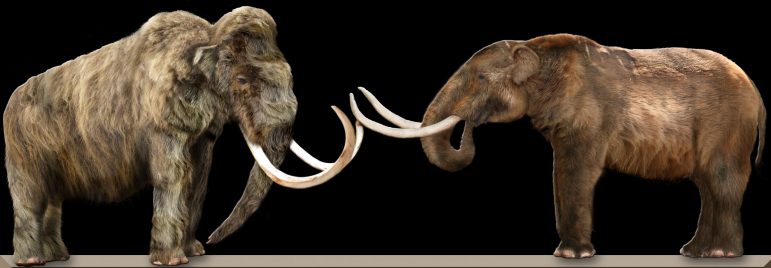
Mammoth (left) and mastodon (right). Image: Wikimedia Commons
By Max Johnston
In the 1920s, the last of the gray wolves were hunted down in Yellowstone National Park, creating a boom in elk populations that wreaked havoc on the landscape.
The same thing may have happened to mammoths in the Great Lakes region more than 12,000 years ago, according to a recent study.
The absence of wolves in Yellowstone created a “boom and bust” cycle of elk. No longer hunted by wolves, their populations would increase “through the roof,” said Chris Widga, a paleontologist at East Tennessee University.
But that wasn’t necessarily good for the herd.
“The population would increase to the point when they would run out of food, and then they would crash,” Widga said.
Mammoths and their distant cousin mastodons may have experienced a similar boom and bust cycle, said Widga, the lead author of a new study published in the academic journal Boreas. Widga and his team propose a theory contradicting many popular scenarios for the extinction of creatures that grew as tall as 15 feet and weighed up to six tons.
The paleontologists examined mammoth and mastodon remains from 47 sites across the Midwest. While they found evidence of humans hunting mammoths and climatic changes, neither seemed to affect populations as much as previously believed.
However, several carnivorous animal populations were affected. Saber-toothed cats, dire wolves and other mammoth predators appeared to die off from hunting and from climatic changes, according to the study.
“There were these really big predators and they died out from the Midwest,” Widga said. “The mammoths and mastodons that were around when [the predators] went extinct, it didn’t look like they were being hunted or scavenged.”
The absence of predators could have created an overabundance of mammoths that ate up all the vegetation and ran out of food, causing populations to plummet, according to the study.
Before the last ice age, the Great Lakes area was a vibrant habitat for the elephant-like creatures, said Daniel Fischer, a professor of paleontology at the University of Michigan.
“They were here in some numbers, with thousands of specimens in the Great Lakes region, and those are just a fraction of those that are out there,” Fischer said. “It was a productive environment with a lot for large herbivores to eat.”
Paleontologists agree that during the Pleistocene epoch, also known as the ice age, mammoths wandered throughout the Great Lakes region, before dying off.

Mammoths and mastodons wandered the Great Lakes region during the Pleistocene epoch. Image: Wikimedia Commons
That’s about where the agreements end. Paleontologists have long debated over exactly how mammoths and mastodons in the region went extinct. For decades, three theories on mammoth extinction were common among paleontologists: climate change, human hunting and an “extraterrestrial event” involving a comet or asteroid, Fischer said.
Popular theories on extinction came about in the 1950s and paleontologists have since formed groups based on belief in those theories, said Jeffrey Saunders, a paleontologist for over 40 years and a co-author of the study.
“In those early years people said humans were probably linked to their downfall, others said we had come out of the ice age and there were climatic changes,” said Saunders, formerly of the Illinois State Museum. “Then people fell into camps.”
Many theories were debated and dismissed with little consensus, Fischer said.
“Some ideas have proponents, have their moments in the sun, but in the end are not really compatible with a lot of observations,” Fischer said. “It’s almost luck of the draw, there are people that would go with any of those.”
But Widga and his team don’t. He said their research doesn’t correspond with any existing theories.
“Our data was not pointing to any particular scenario that already existed,” Widga said. “That’s part of this study. This is a lot more complicated than we thought.”
Some paleontologists like Fischer remain reluctant to say that people did not have a role in the demise of the creatures.
“The research itself isn’t divisive, people come at it different ways with different answers,” Fischer said. “I believe there is more evidence of human interaction and impact on populations than this paper acknowledged.”